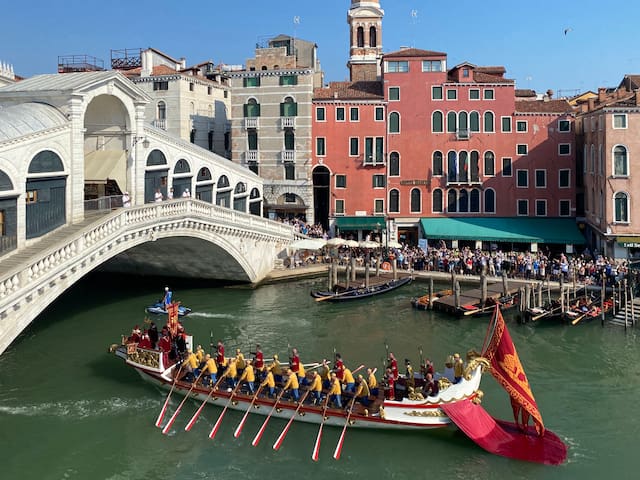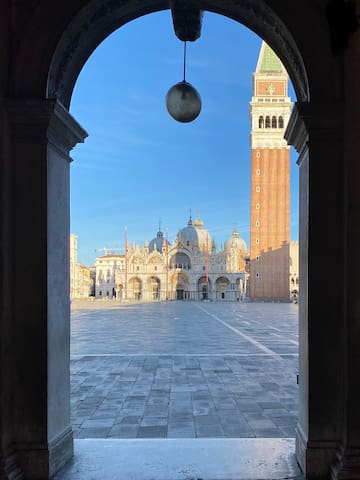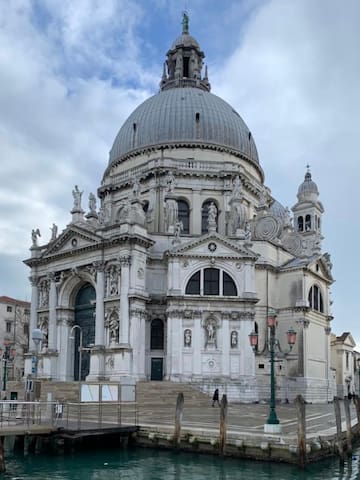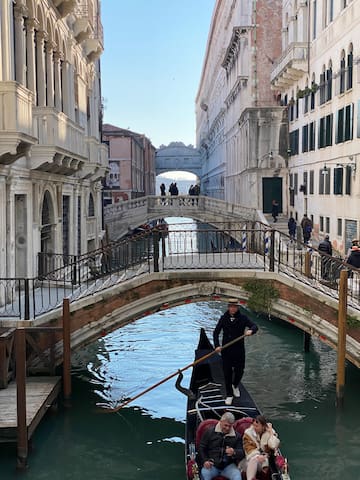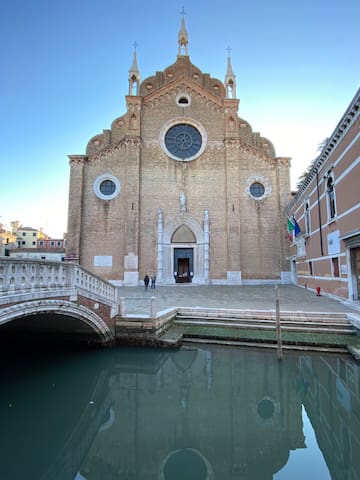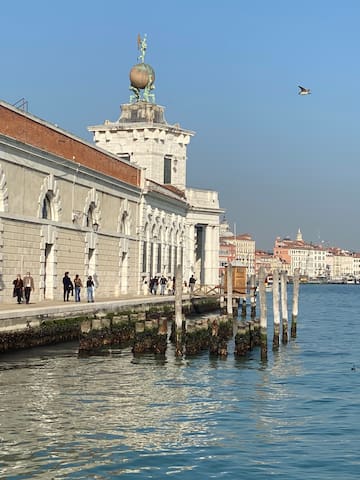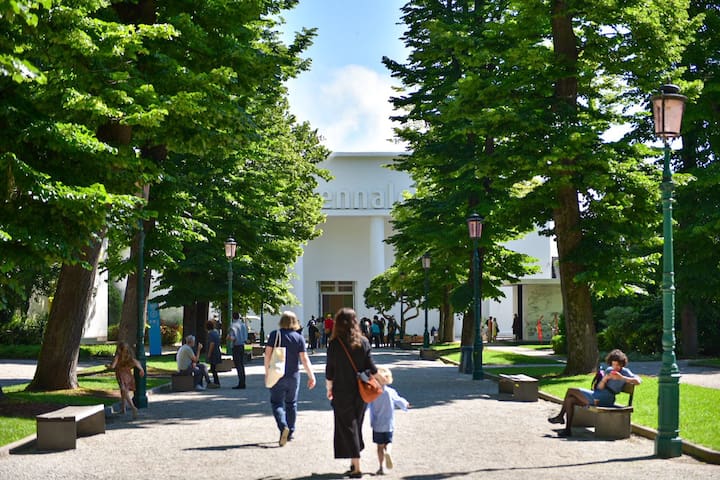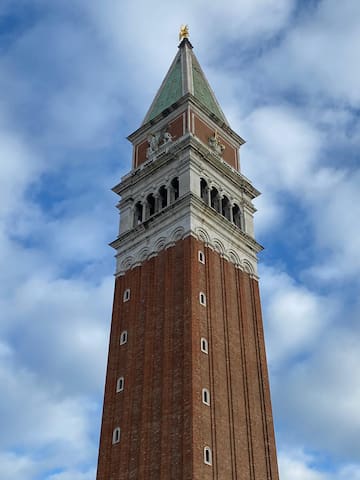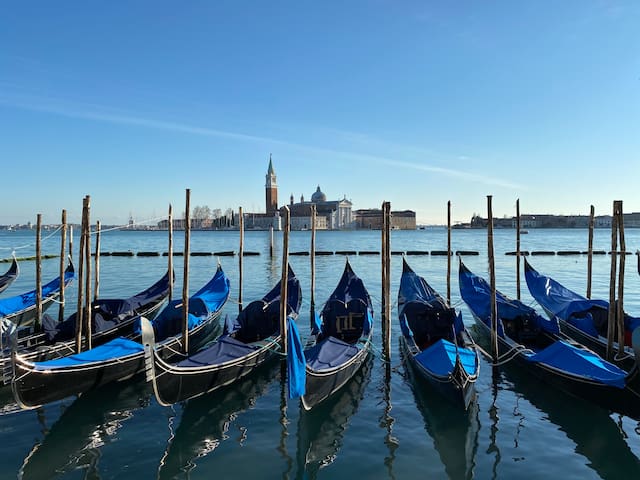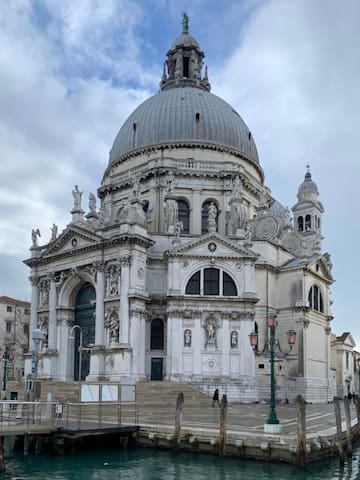Visite turistiche
The Rialto Bridge is one of the most famous symbols of Venice and allows you to connect the two banks of the famous Grand Canal. It was originally made of wood and is now made of stone, housing 24 small tourist shops on either side.
The Rialto Bridge is one of the most famous monuments of Venice. With an arch of 28 meters that allows even the largest boats to pass under it and an almost 500-year-old foundation of elm and larch stilt houses, this bridge is a true marvel of medieval engineering.
564 người dân địa phương đề xuất
Cầu Rialto
Sestiere San Polo
The Rialto Bridge is one of the most famous symbols of Venice and allows you to connect the two banks of the famous Grand Canal. It was originally made of wood and is now made of stone, housing 24 small tourist shops on either side.
The Rialto Bridge is one of the most famous monuments of Venice. With an arch of 28 meters that allows even the largest boats to pass under it and an almost 500-year-old foundation of elm and larch stilt houses, this bridge is a true marvel of medieval engineering.
The one named after San Marco is the only square in Venice, in name and in fact, as all the other urban spaces with this function are called campi or campielli. Napoleon Bonaparte called it "the most beautiful hall in Europe".
344 người dân địa phương đề xuất
Piazza San Marco
The one named after San Marco is the only square in Venice, in name and in fact, as all the other urban spaces with this function are called campi or campielli. Napoleon Bonaparte called it "the most beautiful hall in Europe".
The basilica was built to celebrate the end of the plague, which decimated the population of the area now occupied by the Veneto. It was wanted by the Serenissima as a prayer and as a thank you to the Virgin Mother of God for preserving the city of Venice from the terrible plague of the seventeenth century. The architect of the Salute was the same of Ca 'Rezzonico, Baldassare Longhena. The construction of the church was completed in 1687, 56 years after the beginning of the works.
161 người dân địa phương đề xuất
Nhà thờ Santa Maria della Salute
1 DorsoduroThe basilica was built to celebrate the end of the plague, which decimated the population of the area now occupied by the Veneto. It was wanted by the Serenissima as a prayer and as a thank you to the Virgin Mother of God for preserving the city of Venice from the terrible plague of the seventeenth century. The architect of the Salute was the same of Ca 'Rezzonico, Baldassare Longhena. The construction of the church was completed in 1687, 56 years after the beginning of the works.
The Doge's Palace is the sum of the strength and longevity of the Republic of Venice, seat of the city government and of the major political and judicial offices and home of the Doge. The Magistracy of the Council was located within it. dei X, the Senate, the assembly hall of the Maggior Consiglio From the ground floor, where the services to the public are housed, the route begins with the Opera Museum and, passing through the extraordinary courtyard, continues towards the upper rooms of the Palace with the visit of the precious rooms of the Ducal Apartment, on the first floor, and of the Institutional Rooms that develop between the second floor and the floor of the Loggias, to finally end with a visit to the Armory and the Prisons.
429 người dân địa phương đề xuất
Doge's Palace
1 P.za San MarcoThe Doge's Palace is the sum of the strength and longevity of the Republic of Venice, seat of the city government and of the major political and judicial offices and home of the Doge. The Magistracy of the Council was located within it. dei X, the Senate, the assembly hall of the Maggior Consiglio From the ground floor, where the services to the public are housed, the route begins with the Opera Museum and, passing through the extraordinary courtyard, continues towards the upper rooms of the Palace with the visit of the precious rooms of the Ducal Apartment, on the first floor, and of the Institutional Rooms that develop between the second floor and the floor of the Loggias, to finally end with a visit to the Armory and the Prisons.
The Bridge of Sighs is one of the most representative symbols of Venice. It is located a few steps from Piazza San Marco and connects the Doge's Palace through the ancient prisons. It was given this name because tradition has it that, at the time of the Serenissima, the prisoners, crossing it, sighed at the prospect of seeing the outside world for the last time. The name of "Bridge of Sighs" is already attested at the end of the eighteenth century.
124 người dân địa phương đề xuất
Cầu Thở
1 P.za San MarcoThe Bridge of Sighs is one of the most representative symbols of Venice. It is located a few steps from Piazza San Marco and connects the Doge's Palace through the ancient prisons. It was given this name because tradition has it that, at the time of the Serenissima, the prisoners, crossing it, sighed at the prospect of seeing the outside world for the last time. The name of "Bridge of Sighs" is already attested at the end of the eighteenth century.
The basilica of Santa Maria Gloriosa dei Frari, commonly known only as the Frari, is the largest of the churches in Venice and received the title of minor basilica from Pope Pius XI in 1926. It is located in the homonymous Campo dei Frari, in the San Polo district, and is dedicated to the Assumption of Mary. Inside there are many works of art, including two paintings by Titian. It also houses tombs and funeral monuments of numerous personalities linked to Venice, including Claudio Monteverdi, Titian himself, Antonio Canova, as well as numerous doges.
178 người dân địa phương đề xuất
Nhà thờ chính tòa dei Frari
The basilica of Santa Maria Gloriosa dei Frari, commonly known only as the Frari, is the largest of the churches in Venice and received the title of minor basilica from Pope Pius XI in 1926. It is located in the homonymous Campo dei Frari, in the San Polo district, and is dedicated to the Assumption of Mary. Inside there are many works of art, including two paintings by Titian. It also houses tombs and funeral monuments of numerous personalities linked to Venice, including Claudio Monteverdi, Titian himself, Antonio Canova, as well as numerous doges.
The Fenice Theater is one of the most prestigious theaters in the world, as well as the place where world premieres of works by artists including Giuseppe Verdi, Gioachino Rossini, Vincenzo Bellini, Gaetano Donizetti were staged; it is located in the San Marco district. The theater, designed by Gian Antonio Selva and built between 1790 and 1792.
323 người dân địa phương đề xuất
Teatro La Fenice
1965 Campo S. FantinThe Fenice Theater is one of the most prestigious theaters in the world, as well as the place where world premieres of works by artists including Giuseppe Verdi, Gioachino Rossini, Vincenzo Bellini, Gaetano Donizetti were staged; it is located in the San Marco district. The theater, designed by Gian Antonio Selva and built between 1790 and 1792.
Punta della Dogana is an area of Venice with unique characteristics: with its pointed triangular-shaped building, its lighthouse more than 6 meters high, it was once the access point for all the trade routes that brought goods to the large market of Rialto. The thin triangular point of division between the Grand Canal and the Giudecca Canal, overlooking the San Marco Basin.
193 người dân địa phương đề xuất
Punta della Dogana
2 Dorsoduro
Punta della Dogana is an area of Venice with unique characteristics: with its pointed triangular-shaped building, its lighthouse more than 6 meters high, it was once the access point for all the trade routes that brought goods to the large market of Rialto. The thin triangular point of division between the Grand Canal and the Giudecca Canal, overlooking the San Marco Basin.
The Venice Biennale is an Italian cultural foundation based in Venice. Mainly active in the figurative arts - but also in music, cinema, theater, architecture and dance - it is considered the most important cultural foundation of its kind in Italy and among the most important in the world; since 1895 it has organized the Venice International Art Exhibition, every two years.
240 người dân địa phương đề xuất
Arsenale della Biennale di Venezia
2169 Campo de la TanaThe Venice Biennale is an Italian cultural foundation based in Venice. Mainly active in the figurative arts - but also in music, cinema, theater, architecture and dance - it is considered the most important cultural foundation of its kind in Italy and among the most important in the world; since 1895 it has organized the Venice International Art Exhibition, every two years.
The Peggy Guggenheim Collection is one of the most important museums of 20th century European and American art in Italy. It is based in Venice at Palazzo Venier dei Leoni, on the Grand Canal, in what was once the home of Peggy Guggenheim.The personal collection of Peggy Guggenheim is made up of important works by many of the major protagonists of the artistic currents of the twentieth century: Cubism , Futurism, European Abstractionism, Metaphysical Painting, Surrealism, and American Abstract Expressionism. Piet Mondrian, Pablo Picasso, Paul Klee, René Magritte, Wassily Kandinsky, Jackson Pollock, Henry Moore…. the list of artists is simply too long to be fully reported.
Bộ sưu tập Peggy Guggenheim
701-704 DorsoduroThe Peggy Guggenheim Collection is one of the most important museums of 20th century European and American art in Italy. It is based in Venice at Palazzo Venier dei Leoni, on the Grand Canal, in what was once the home of Peggy Guggenheim.The personal collection of Peggy Guggenheim is made up of important works by many of the major protagonists of the artistic currents of the twentieth century: Cubism , Futurism, European Abstractionism, Metaphysical Painting, Surrealism, and American Abstract Expressionism. Piet Mondrian, Pablo Picasso, Paul Klee, René Magritte, Wassily Kandinsky, Jackson Pollock, Henry Moore…. the list of artists is simply too long to be fully reported.
The bell tower of San Marco is one of the most important symbols of the city of Venice. 98.6 meters high, it is one of the tallest bell towers in Italy, standing isolated in a corner of Piazza San Marco in front of the basilica. Built on the remains of Roman times in the 9th century, in the past, it was used as a lighthouse for ships and only in 1515 did it take on its current appearance. It consists of a brick barrel, above which the belfry is located. This, on the sides, shows alternately the figures of two lions and two women, both symbolizing "Justice".
105 người dân địa phương đề xuất
Campanile di San Marco
Piazza San MarcoThe bell tower of San Marco is one of the most important symbols of the city of Venice. 98.6 meters high, it is one of the tallest bell towers in Italy, standing isolated in a corner of Piazza San Marco in front of the basilica. Built on the remains of Roman times in the 9th century, in the past, it was used as a lighthouse for ships and only in 1515 did it take on its current appearance. It consists of a brick barrel, above which the belfry is located. This, on the sides, shows alternately the figures of two lions and two women, both symbolizing "Justice".
The Ghetto was the district of Venice where Jews were forced to reside during the period of the Republic of Venice, starting from 1516. It is located in the Cannaregio district, it has remained the hub of the Jewish community of Venice and is home to synagogues and other religious institutions.
In medieval times, the Ghetto was the area of the city where the public foundries were concentrated and only starting from 1516 was it used as a compulsory residence for Jews. From here the common name ghetto is derived to indicate a Jewish quarter and, in an even broader sense, a district in which the socially excluded minorities of a community are concentrated.
87 người dân địa phương đề xuất
Jewish Ghetto
2882 Calle Ghetto VecchioThe Ghetto was the district of Venice where Jews were forced to reside during the period of the Republic of Venice, starting from 1516. It is located in the Cannaregio district, it has remained the hub of the Jewish community of Venice and is home to synagogues and other religious institutions.
In medieval times, the Ghetto was the area of the city where the public foundries were concentrated and only starting from 1516 was it used as a compulsory residence for Jews. From here the common name ghetto is derived to indicate a Jewish quarter and, in an even broader sense, a district in which the socially excluded minorities of a community are concentrated.
Just four hundred meters divide Piazza San Marco from this other little jewel of the lagoon: the island of San Giorgio Maggiore. The first building you will see when arriving here is the imposing church of the same name designed by architect Andrea Palladion in 1565.
The history of this island is very ancient and troubled, passing from the Benedictine monks to the Napoleonic domination up to the Austrian one. And what was once a monastery became a prison, then an arms depot, a factory and a military district.
San Giorgio Maggiore
Just four hundred meters divide Piazza San Marco from this other little jewel of the lagoon: the island of San Giorgio Maggiore. The first building you will see when arriving here is the imposing church of the same name designed by architect Andrea Palladion in 1565.
The history of this island is very ancient and troubled, passing from the Benedictine monks to the Napoleonic domination up to the Austrian one. And what was once a monastery became a prison, then an arms depot, a factory and a military district.
The Acqua Alta bookshop is a bit like Venice: a labyrinth of narrow and dark alleys, made up of tall piles of beautiful books to buy or consult.
You will find them on a gondola, in a bathtub, on a wooden boat.
You will find an open back room, where books are used as steps, to see the canal that flows beyond the wall. The Acqua Alta bookshop is simply one of the most beautiful bookstores in the world.
189 người dân địa phương đề xuất
libreria Acqua alta
5176b C. Longa Santa Maria FormosaThe Acqua Alta bookshop is a bit like Venice: a labyrinth of narrow and dark alleys, made up of tall piles of beautiful books to buy or consult.
You will find them on a gondola, in a bathtub, on a wooden boat.
You will find an open back room, where books are used as steps, to see the canal that flows beyond the wall. The Acqua Alta bookshop is simply one of the most beautiful bookstores in the world.
The basilica was built to celebrate the end of the plague, which decimated the population of the area now occupied by the Veneto. It was wanted by the Serenissima as a prayer and as a thank you to the Virgin Mother of God for preserving the city of Venice from the terrible plague of the seventeenth century. The architect of the Salute was the same of Ca 'Rezzonico, Baldassare Longhena. The construction of the church was completed in 1687, 56 years after the beginning of the works.
161 người dân địa phương đề xuất
Nhà thờ Santa Maria della Salute
1 DorsoduroThe basilica was built to celebrate the end of the plague, which decimated the population of the area now occupied by the Veneto. It was wanted by the Serenissima as a prayer and as a thank you to the Virgin Mother of God for preserving the city of Venice from the terrible plague of the seventeenth century. The architect of the Salute was the same of Ca 'Rezzonico, Baldassare Longhena. The construction of the church was completed in 1687, 56 years after the beginning of the works.
Ca' Rezzonico is a splendid palace on the Grand Canal built on a project by Baldassarre Longhena: since 1936 it has been the seat of the Venetian eighteenth-century Museum. The rich residence, in addition to the original frescoes by Giambattista Tiepolo and Giambattista Crosato, houses a precious collection of furnishings, paintings and sculptures from the Venetian eighteenth century. Among these stand out the paintings by Antonio Canaletto, Francesco Guardi, Giambattista Piazzetta, Rosalba Carriera, Pietro Longhi, the sculptures by Antonio Corradini, Andrea Brustolon, Filippo Parodi, Giusto Le Court, as well as the exuberant furnishings of the seventeenth and eighteenth centuries, flanked by a precious collection of porcelain, with specimens of the most important Venetian and European manufactures of the eighteenth century.
78 người dân địa phương đề xuất
Ca' Rezzonico
3136 DorsoduroCa' Rezzonico is a splendid palace on the Grand Canal built on a project by Baldassarre Longhena: since 1936 it has been the seat of the Venetian eighteenth-century Museum. The rich residence, in addition to the original frescoes by Giambattista Tiepolo and Giambattista Crosato, houses a precious collection of furnishings, paintings and sculptures from the Venetian eighteenth century. Among these stand out the paintings by Antonio Canaletto, Francesco Guardi, Giambattista Piazzetta, Rosalba Carriera, Pietro Longhi, the sculptures by Antonio Corradini, Andrea Brustolon, Filippo Parodi, Giusto Le Court, as well as the exuberant furnishings of the seventeenth and eighteenth centuries, flanked by a precious collection of porcelain, with specimens of the most important Venetian and European manufactures of the eighteenth century.
The school of San Rocco owes its importance to the relics of the patron saint of the plague, stolen from Montpellier and arrived in Venice in 1485. In 1516 the current seat was built on a project by Bartolomeo Bon, then removed due to differences with the brothers. The second floor and the upper part of the facade were completed by Antonio Abbondi, known as Lo Scarpagnino (1527-1541). Inside there is one of the most extraordinary cycles of canvases made by Tintoretto still placed in the original position.
It took the artist 24 years to complete the decoration of the walls and ceilings at the School. At the Ground Hall it is possible to admire the Annunciation, where the Madonna is depicted as a country girl and the Angel literally seems to breach the wall. On the ceiling of the hotel room appears the painting San Rocco in glory with which Tintoretto won the competition for the decoration of the School and obtained the commission for the works.
26 người dân địa phương đề xuất
Scuola Grande di San Marco
The school of San Rocco owes its importance to the relics of the patron saint of the plague, stolen from Montpellier and arrived in Venice in 1485. In 1516 the current seat was built on a project by Bartolomeo Bon, then removed due to differences with the brothers. The second floor and the upper part of the facade were completed by Antonio Abbondi, known as Lo Scarpagnino (1527-1541). Inside there is one of the most extraordinary cycles of canvases made by Tintoretto still placed in the original position.
It took the artist 24 years to complete the decoration of the walls and ceilings at the School. At the Ground Hall it is possible to admire the Annunciation, where the Madonna is depicted as a country girl and the Angel literally seems to breach the wall. On the ceiling of the hotel room appears the painting San Rocco in glory with which Tintoretto won the competition for the decoration of the School and obtained the commission for the works.
Burano, one of the three main islands of the Venice lagoon, is the place where the rainbow seems to dwell there. Among colors and lace, in the enchantment of its village, many visitors find themselves dreaming.
323 người dân địa phương đề xuất
Burano
Burano, one of the three main islands of the Venice lagoon, is the place where the rainbow seems to dwell there. Among colors and lace, in the enchantment of its village, many visitors find themselves dreaming.

